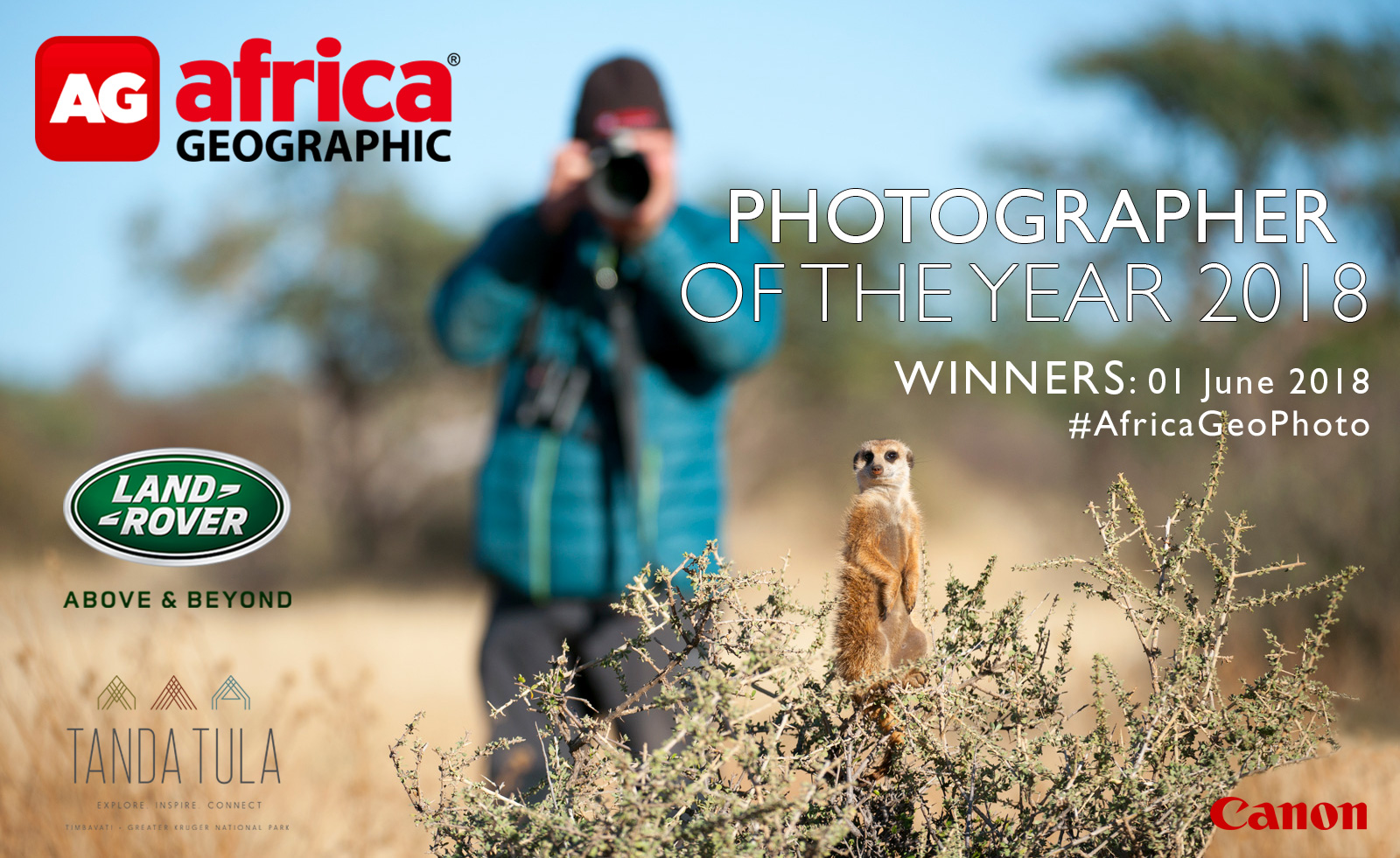
Photographer of the Year 2018 Winners

2018 Photographer of the Year 2018 Winners
MESSAGE FROM OUR CEO:
What a privilege it is to receive these fantastic images from all over the world, and to have this first-hand feel for the experiences our community members enjoy across this fantastic continent we are lucky enough to call home!
We received 25,593 entries to the 2018 Photographer of the Year competition, up from 15,171 last year, and the standard of entries was again spectacular. Reducing that incredible volume to one winner was a fantastic journey for my team and I. We met each week over the five months to make a weekly selection, and then during the judging month of May, we had the tough job of choosing the photos that we feel stand out this year. A daunting task indeed.
Our approach to what makes a good photograph is primarily based on whether that photograph evokes an emotion, tells a story and reflects the true diversity and amazingness of Africa. Of course, there are technical issues to consider, and these are important. But most important for us is that the photograph breaks through the clutter of everyday life and makes you FEEL Africa’s pulse.
This year the 25 images that made it into the final round were of a similarly high standard, and choosing an overall winner, two runners-up and seven commendable finalists was especially tricky. The final choices were made based on the underlying message communicated by the images.
I want to thank our sponsors Land Rover South Africa, Canon South Africa and Tanda Tula – because in these days where just about everything has been commoditised, they understand that quality ALWAYS trumps quantity.
Lastly, a special thank you to everybody who entered this fantastic display of Africa’s wealth. Please do so again in 2019.
~ Simon Espley, CEO
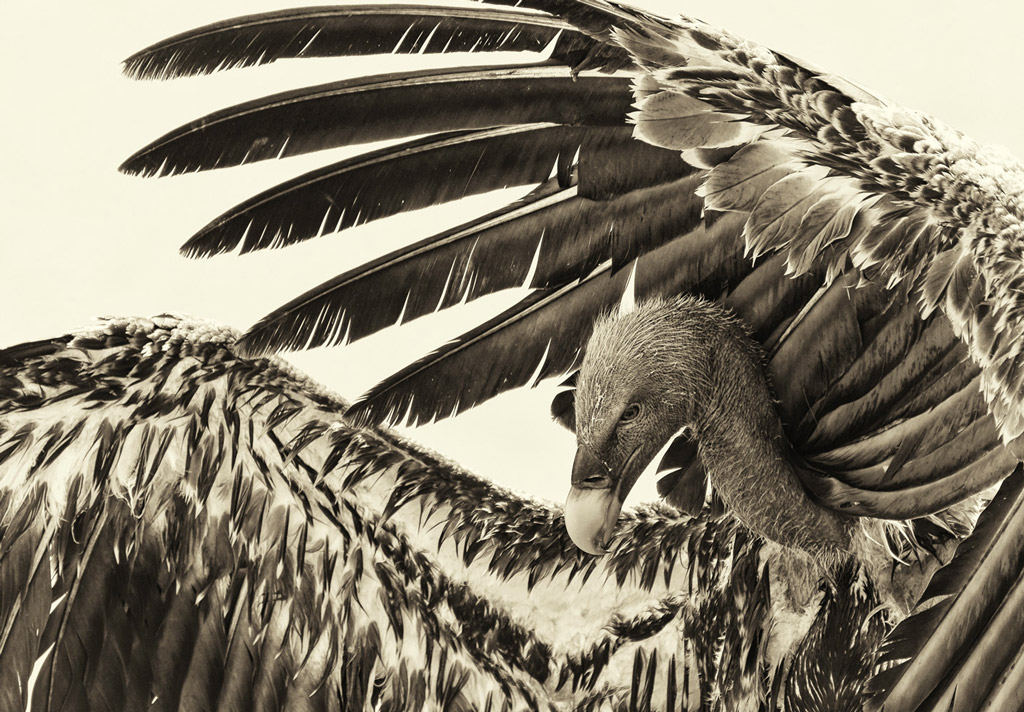
WINNER – 2018 PHOTOGRAPHER OF THE YEAR
Sushil Chauhan – A Rüppell’s vulture in Maasai Mara National Reserve, Kenya
“While waiting for over two hours in the hot equatorial sun for a migration crossing to happen, I decided to change my focus to a group of vultures that were feeding on a drowned wildebeest carcass. Fully fed, this beauty decided to dry off its wings in the sun, which produced this interesting image of a great raptor. These raptors face many problems, from loss of habitat, reduced breeding sites, and reduction in large ungulates (resulting in fewer sources of food), to death from poisoning, the witchcraft trade and collisions with power lines. They play such an important role in making sure that diseases such as rabies and anthrax do not spread, and they also help cycle nutrients back into the ecosystem. We must help conserve these amazing raptors at all costs.”
Judges’ comments:
This amazing image portrays vultures for what they are – majestic and regal birds that deserve our respect. This sensitive representation of one of Africa’s most threatened birds is a refreshing change from the stereotypical vulture image of bloodied hoodlums fighting for scraps of meat. The coincidental draping of another vulture’s wing over the head of this bird is almost ‘angelic’ and adds to the dignity of the image.
ABOUT SUSHIL CHAUHAN
I am a Kenyan wildlife enthusiast, nature lover and keen photographer. Trained professionally as a safari consultant and guide, my most profound passion has always been to work with wildlife and travel the world. My goal is to take photographs that create awareness about wildlife, conservation and wilderness areas.

FIRST RUNNER-UP
Stuart Sinclair – A baby mountain gorilla gets all the attention in Volcanoes National Park, Rwanda
“This photo was taken in Volcanoes National Park in Rwanda. Walking into this family of gorillas was spectacular. They were so comfortable in our presence, very relaxed and observant. It was amazing to see their strong family bond, and this photo highlights that. After a short time, they played and fed in front of us. Some of the youngsters ran through the group, seemingly knowing that it would cause a stir, and enjoying the reaction!”
Judges’ comments:
This touching image speaks volumes about family bonds and parental pride. The close framing adds to the intimacy of the moment, and the eye contact from father and infant drags you in. Those of us who are lucky enough to have been gorilla-trekking understand the technical difficulties in low-light conditions, thick vegetation and the limited available time.
ABOUT STUART SINCLAIR
I was born in Zimbabwe but moved to Australia as a child 22 years ago. Africa is well and truly in my blood, though, and I love getting back as often as possible. There is something magical about the wildlife in Africa. It’s so important that we cherish and protect it for future generations.
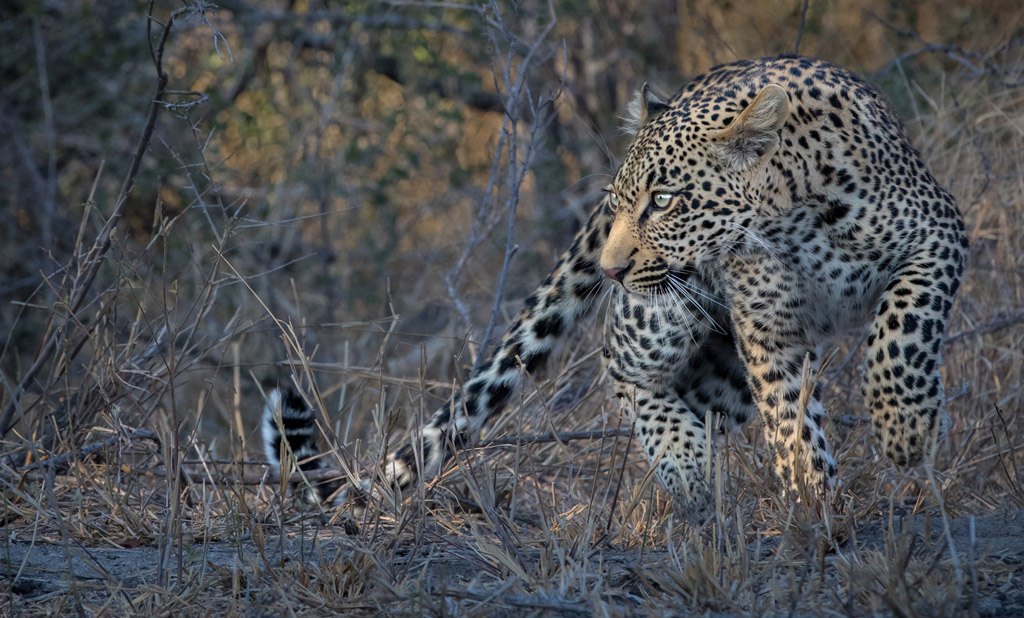
SECOND RUNNER-UP
Annemarie du Plessis – A male leopard stalks guineafowl in the early morning golden light in Sabi Sands Game Reserve, Greater Kruger National Park, South Africa
“This young male leopard was stalking guineafowl during the early morning, paying absolutely no attention to our game drive vehicle in the Greater Kruger. We were following him for quite a while, and then he disappeared into the bushes, following the unsuspecting guineafowl. He suddenly appeared from the bushes behind us and stalked into an open area, providing me with the perfect opportunity to get this shot. What makes this shot so much more special to me is the streak of sunlight creeping through the bushes and onto his face. He may have missed the guineafowl, but I got my shot!”
Judges’ comments:
We found ourselves caught in the moment with this stalking leopard, wondering what he was hunting and when he would pounce. The framing of his tightly-coiled yet light-footed body and curled tail occupies the entire image and creates a sense of fluid motion. The intense concentration so evident in his piercing eyes also helps to balance the image.
ABOUT ANNEMARIE DU PLESSIS
Wildlife photography is my absolute passion and sadly, only a hobby. I would love to be in nature permanently, capturing all happenings and sightings to the audience at home! I am a businesswoman and co-owner of Zanis Gymnastics Academy in Polokwane, Limpopo in South Africa. My love for wildlife and nature started at a young age, and since then it has just grown – and with Kruger only 3 hours away, I can live my passion! Initially, I decided to start a Facebook page to share my images with the people at home. The response was overwhelming, and due to my supporters’ demand, I started entering small competitions. Africa Geographic is supplying a massive platform for us amateur photographers, and it is the second year that I have entered. In 2017, my image of the majestic elephant bull was under the Top 24 images and printed in their high-quality coffee table book – a first for me!

COMMENDABLE FINALIST
Andrea Galli – A gorilla inspects a shoe in Bwindi Impenetrable National Park, Uganda
“The rule says that you should keep a 7-metre distance from gorillas… but what can you do if you are stuck between a silverback and some curious youngsters who want to play? You just stay put and enjoy… One of them tried to steal my camera, and after a talking-to from the guide he just pretended he was doing nothing wrong, and with nonchalance started playing with the shoelaces of a guest close to me…”
Judges’ comments:
This image spoke to us of that push-pull tension between man and beast. Humans are the cause of the rapid decline in mountain gorilla populations, and yet without the tourism dollar and 24/7 involvement on the ground from local human inhabitants, government employees, researchers and conservationists, this critically endangered great ape would surely go extinct. Andrea’s caption explains that the young gorilla was keen to engage, and in so doing ‘disobeyed’ the strictly-enforced proximity rules – adding a touch of humour to the conservation message.
ABOUT ANDREA GALLI
Born and bred in Italy on Lake Como, my wife, Linda Oteri and I decided to follow our passion for wildlife photography and moved to Johannesburg 3 years ago. Here we founded Wildshot Safaris, and now we organise photographic tours and tailor-made trips.

COMMENDABLE FINALIST
Andrew Campbell – Two elephant bulls fight under a stormy sky in Amboseli National Park, Kenya
“I watched these two bulls sparring for over an hour on a floodplain in Amboseli in Kenya. At first, there were clear skies, and then a huge storm built up above and around them. What with the dust, the clouds, the light, the drama and the action it was truly an incredible scene and I was lucky to pop off a few shots before they eventually moved off.”
Judges’ comments:
There is so much going on in this dramatic image – and we were all transported there to watch these giants fight it out. The energy of the moment is palpable, and the combination of sparring elephants and threatening clouds with the subtlety of swirling dust and shafts of sunlight make this an evocative image.
ABOUT ANDREW CAMPBELL
Having been born and brought up in Kenya, I have had the luxury of living a good deal of my life on safari. I am now lucky enough to live a lifelong dream, and my passion for the great outdoors has now become my job, and the bush is now my office.

COMMENDABLE FINALIST
Andy Howe – Leopard cub and its meal in Olare Motorogi Conservancy, Maasai Mara National Reserve, Kenya
“This is a four-month-old cub of the leopardess called Fig, in the Olare Motorogi Conservancy in Kenya. We found Fig about a kilometre away from her cub, where she had been resting up for most of the day. She eventually made her way back to her cub’s location, and as they were greeting each other, a hare appeared in the acacia scrub nearby. Fig didn’t think twice, and the unsuspecting hare had no chance as she quickly caught and killed it. She was immediately joined by the cub who took control of proceedings, with a little guidance from its mother.”
Judges’ comments:
This image speaks of that raw naked instinct that is so essential for survival in the wild, and yet so missing from the modern-day portrayal of wildlife, which tends to be Disney-like and driven by human sensitivities and political correctness. The fierce eye contact from this leopard cub speaks volumes about how tough and resilient Africa is, and of how it will survive despite human efforts to tame it.
ABOUT ANDY HOWE
Andy Howe is a UK-based wildlife photographer, specialising in capturing the personality and character of his subjects with a particular focus on owls and birds of prey. He also loves Africa and its wildlife with a passion. Andy leads small groups of photographers to the Maasai Mara region of Kenya several times a year to photograph the Great Migration and Africa’s big cats. Andy has been honoured, awarded and published internationally in such publications as Bird Guides Bird Photographer of the Year, Nature Photographer of the Year, Africa Geographic, Nature’s Best Awards, to name but a few. Recently he received honours as a Fellow of the Society of International Nature and Wildlife Photographers and also as an Associate of the Royal Photographic Society. Andy also donates images to worthy causes and is currently involved in the charity, Art For Africa exhibition, helping to raise funds for vulnerable and disadvantaged children, as well as also actively helping the Remembering Wildlife charity for critically endangered species.
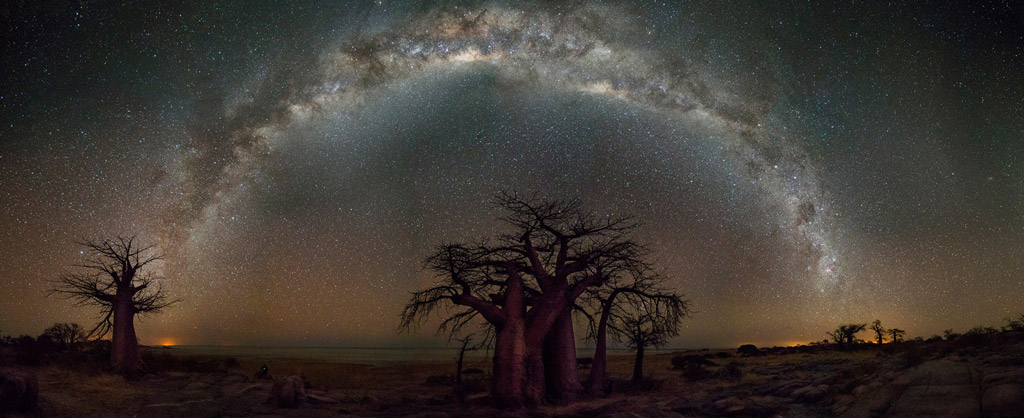
COMMENDABLE FINALIST
Darryn Haltmann – The Milky Way over Baobab Forest at Kubu Island, Botswana
“Kubu Island is as remote as it is picturesque, and I long wanted to return there for some astrophotography. I planned my holiday around getting there at new moon and managed to find this beautiful baobab outcrop when I scouted for locations on the first night and day. I also noted the ambient light on either side from two small towns in the distance and hoped to capture this. Returning on the second night, I managed to capture this Milky Way.”
Judges’ comments:
We were impressed by the technical prowess of this image, and by the sense of mystical awe generated. We love how the photographer anchored each end of the Milky Way halo as it forged its path across the night sky, making a perfect dome over the central group of baobabs.
ABOUT DARRYN HALTMANN
Darryn is a passionate astro and wildlife photographer who enjoys combining his love of nature with his passion for photography. From a young age, he spent hours in the garden photographing birds and reading photography magazines. He honed his skills through various courses, workshops and online tutorials. He believes that the essence of photography is capturing a moment and always strives to use his photos to communicate the inherent beauty of nature.
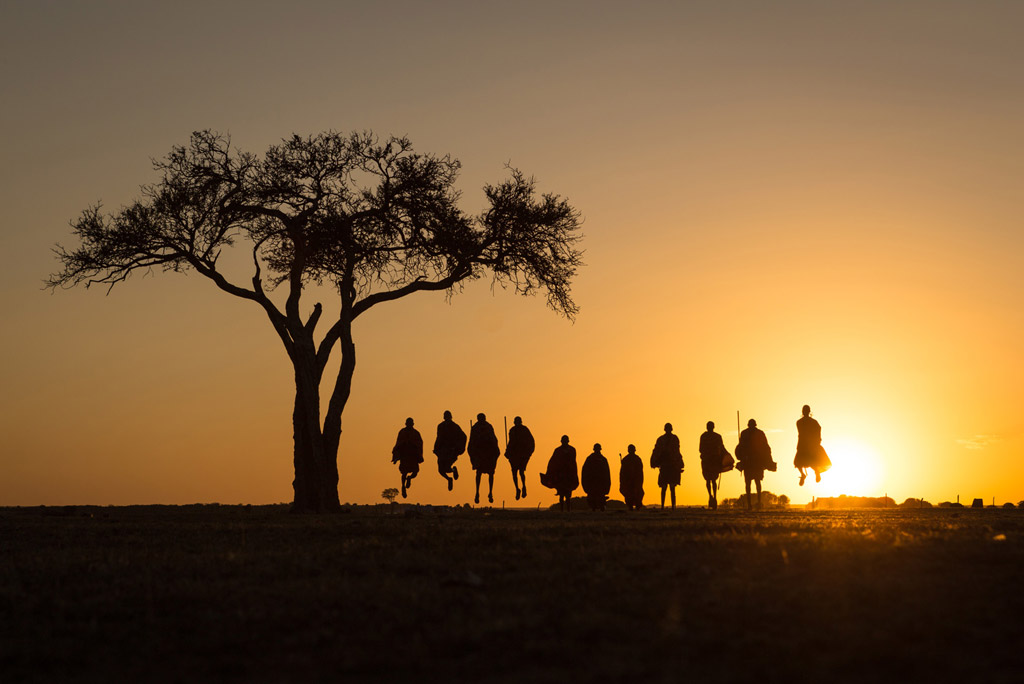
COMMENDABLE FINALIST
John Kerrod Wells – Maasai warriors jump at sunrise near their village on the outskirts the Maasai Mara National Reserve, Kenya
“In the early morning, we were fortunate enough to witness a group of Maasai warriors display their strength and skill as they jumped, framed by the golden light of sunrise. Later at their village, we learned of their history, watched the adamu (the jumping dance), and perused their wares. Another amazing day in Africa!”
Judges’ comments:
This image is all about energy and fun – and instantly drives us into safari mode. Capturing the jumping warriors in the perfect wave formation conveys a sense of constant motion, and the rising sun silhouetting the warriors and etching the quintessentially African umbrella thorn tree adds dollops of romance.
ABOUT JOHN KERROD WELLS
With interest in photography sparked by a photography-loving dad, it was a once in a lifetime trip to Antarctica that turned my hobby into a passion. I love to photograph wildlife, landscapes, cityscapes, and everything in between, while travelling to far off places or at home in Central Queensland, Australia.
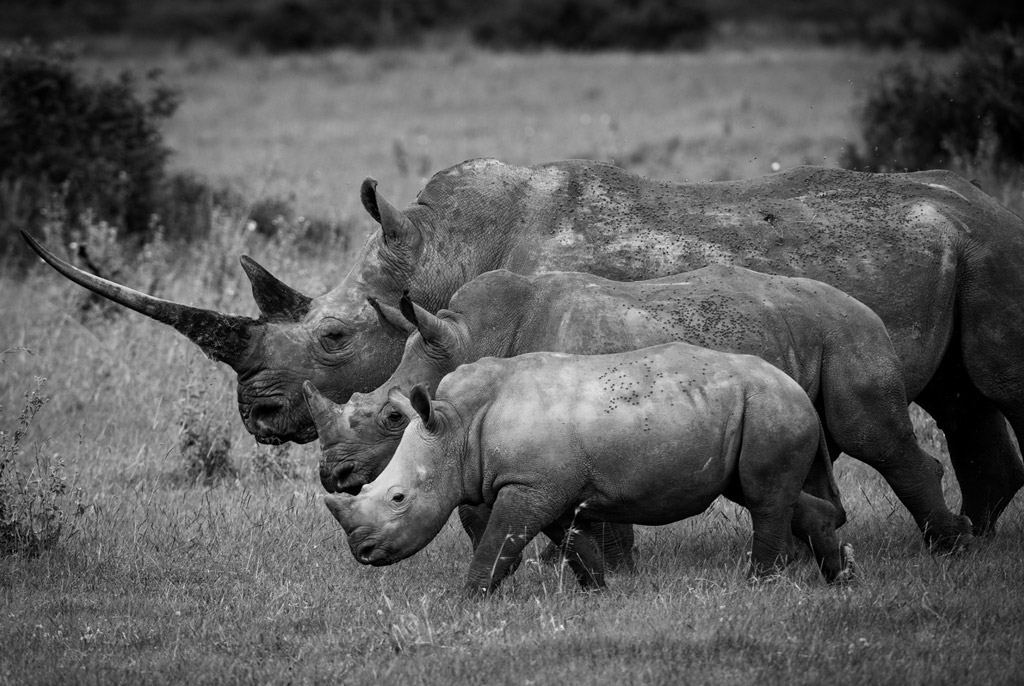
COMMENDABLE FINALIST
Luke Street – A row of white rhinos in a reserve in Kenya
“Laikipia County in Kenya is one of the last strongholds for the white rhino in East Africa. It was a true honour to be able to view these animals in such numbers, under such incredible protection. I was delighted in capturing just about the full spectrum of the different life stages of the white rhino in one image.”
Judges’ comments:
We were overcome with a sense of hope and wonder at seeing three generations of rhinos so perfectly captured. So much coverage these days of rhinos is distressing, and by contrast here is an image that speaks of future generations in safe hands. So many rhino custodians are fighting seemingly insurmountable obstacles in the battle to keep these special unicorns safe, and this image speaks to years of investment and effort by so many people.
ABOUT LUKE STREET
I have always had a deep passion for nature and wildlife, and always knew I wanted to be involved in the industry. I have been a safari guide for the last seven years and for the last three of those years, I have found an incredible passion for nature photography.
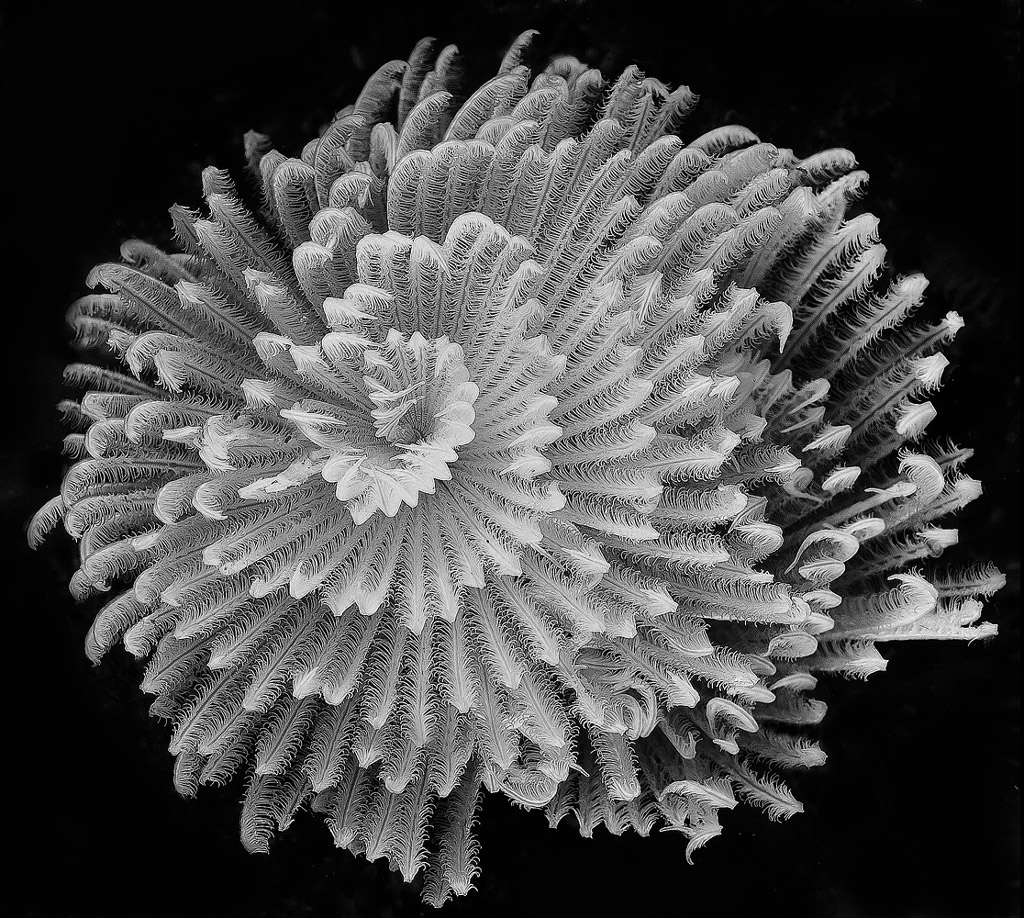
COMMENDABLE FINALIST
Peet J. van Eeden – An attractive feather duster worm in False Bay, Cape Peninsula, South Africa
“The feather duster worm is also known as a mop worm and has a white fan of feeding appendages. The crown of feeding appendages, or radioles, consists of two fan-shaped clusters that project from their tubes when underwater. Each radiole has a paired side of branches, making a two-edged comb for filter feeding. Size varies between tiny to over 10 cm (2.5 in) in length. Some small species can bend over and extend their tentacles to the seafloor to collect food.”
Judges’ comments:
This image immediately drew us in, confused as to what and where. The feathery lace-like detail and sense of swirling motion generate a sense of wonderment, almost to the point of being hypnotic. We know so little about life in the oceans, and this image helps draw us into that realm.
ABOUT PEET J. VAN EEDEN
I am a full-time Gastroenterologist based in Cape Town. As a weekend diver and photographer, I have been involved in underwater photography for over four decades. I specialise in underwater macro photography. My key inspiration remains my love for the world below the waves.

THE “FACEBOOK FAVOURITE” WINNER – as voted by our Facebook community
Henrico Muller – Portrait of a leopard mother and her 6-month-old cub in Thornybush Game Reserve, South Africa
VOTES: 546
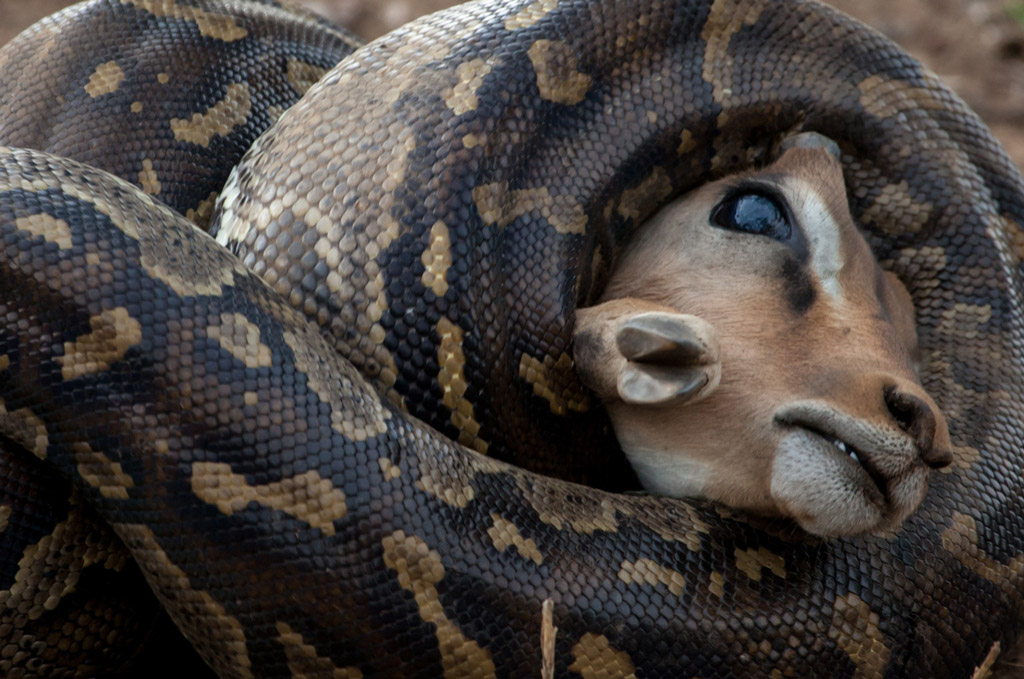
THE “WEBSITE FAVOURITE” WINNER – as voted by visitors to our website
Jennifer Kucherawy – An African rock python kills an impala in Kruger National Park, South Africa
VOTES: 5,553

THE “INSTA FAVOURITE” WINNER – as voted by our Instagram community
Deon Hoon – “Slow dancing” in Pilanesberg Game Reserve, South Africa (Instagram/deon.hoon)
VOTES: 3,804
To comment on this story: Login (or sign up) to our app here - it's a troll-free safe place 🙂.![]()






